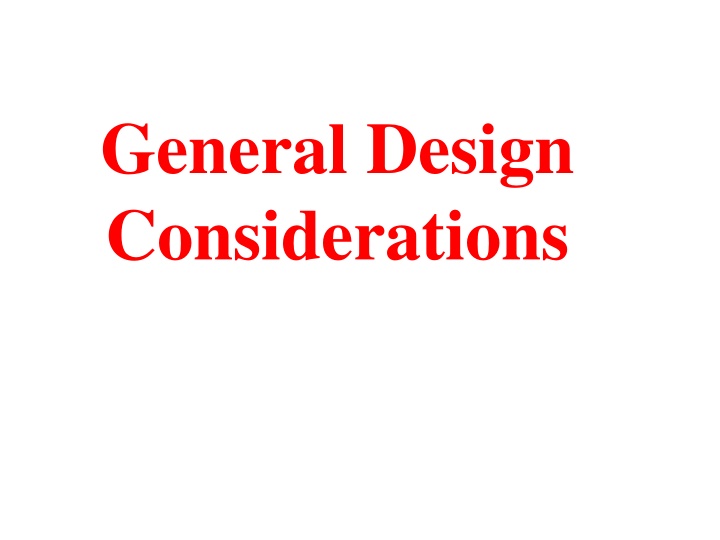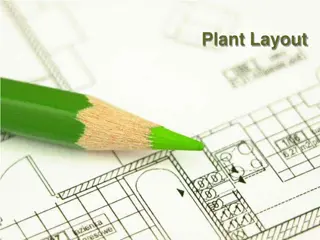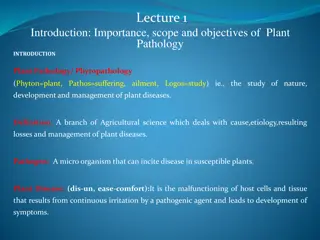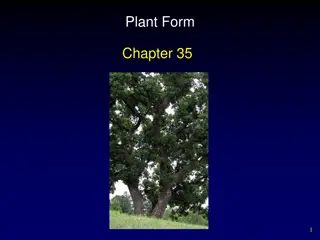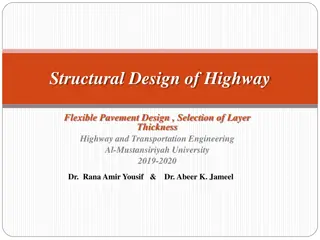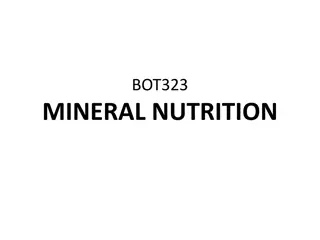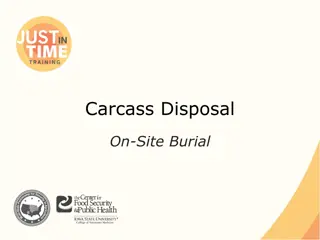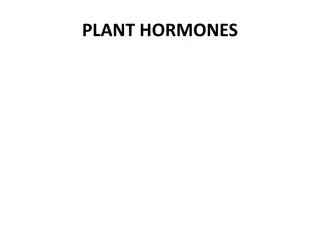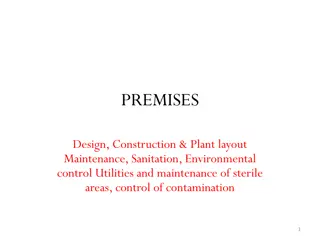Considerations for Plant Design and Site Selection
Various factors such as site selection, utilities, operation, storage, waste disposal, structural design, and health and safety must be considered when developing a complete plant design. Key aspects include choosing a location with minimal production and distribution costs, proximity to markets and raw materials, availability of labor and water supply, energy availability, climate considerations, and efficient site layout for smooth material flow.
Download Presentation

Please find below an Image/Link to download the presentation.
The content on the website is provided AS IS for your information and personal use only. It may not be sold, licensed, or shared on other websites without obtaining consent from the author.If you encounter any issues during the download, it is possible that the publisher has removed the file from their server.
You are allowed to download the files provided on this website for personal or commercial use, subject to the condition that they are used lawfully. All files are the property of their respective owners.
The content on the website is provided AS IS for your information and personal use only. It may not be sold, licensed, or shared on other websites without obtaining consent from the author.
E N D
Presentation Transcript
General Design Considerations
The consideration of many different factors such as: development of a complete plant design requires Site Selection Site and plant layout Utilities Operation and control Storage Waste disposal Structural Design Health and safety
Site Selection The plant should be located where the minimum cost of production and distribution can be obtained. The major factors in the selection of most plant sites are: 1. Marketing area The plant should be located close to the primary market for materials where the cost of transport is a significant fraction of the sales price (cement, fertilizers, mineral acids, etc..) This consideration is much less important for low-volume production and high-priced products, such as pharmaceuticals. 2. Raw Materials The availability and price of suitable raw materials will often determine the site location Plants that produce bulk chemicals are best located close to the source of the major raw material, as long as the costs of shipping product are not greater than the cost of shipping feed. 3. Transportation Facilities If practicable, a site should be selected that is close to at least two major forms of transport: road, rail, waterway (canal or river), or a sea port.
4. Availability of Labors Labor will be needed for construction of the plant and its operation. 5. Water supply Chemical processes invariably require large quantities of water for cooling, washing, steam generation, and as a raw material. The plant must be located near a source of water of suitable quality. Process water may be drawn from a river, from wells, or purchased from a local authority. 6. Energy Availability (power and fuel) Power and steam requirements are high in most industrial plants, and fuel is ordinarily required to supply these utilities. If the plant requires large quantities of coal or oil, location near a source of fuel supply may be essential for economic operation. The local cost of power can help determine whether power should be purchased or self- generated. Electrical power is needed at all sites. Electrochemical processes (for example, chlorine manufacture or aluminum smelting) require large quantities of power and must be located close to a cheap source of power. A competitively priced fuel must be available on site for steam and power generation.
7. Climate Adverse climatic conditions at a site will increase costs. Abnormally low temperatures require the provision of additional insulation and special heating for equipment and pipe runs. Stronger structures are needed at locations subject to high winds (cyclone/ hurricane areas) or earthquakes. Corrosive environments will need strong protection for the plant equipment.
Site layout and plant layout Units should be arranged to give a smooth flow of materials through the various processing steps, from raw material to final product storage. Process units are normally spaced at least 30 m apart; greater spacing may be needed for hazardous processes. In addition to the main processing units, site layout includes the following items: 1. Storage for raw materials and products: tank farms and warehouses; 2. Maintenance workshops; 3. Stores, for maintenance and operating supplies; 4. Laboratories for process quality control; 5. Fire stations and other emergency services; 6. Utilities; 7. Effluent disposal plant: waste water treatment, solid and or liquid waste collection; 8. Offices for general administration; 9. Canteens and other amenity buildings, such as medical centers; 10. Parking lots.
3D Site layout Flare
When you see flaring, please be assured that flares play a key role in keeping refineries and chemical plants running safely. What are flares? Flares are important safety devices used in refineries and petrochemical facilities. They safely burn excess hydrocarbon gases which cannot be recovered or recycled. Excess hydrocarbon gases are burnt in the flare systems in an environmentally-sound manner, as an alternative to releasing the vapor directly into the atmosphere. During flaring, excess gases are combined with steam and/or air, and burnt off in the flare system to produce water vapor and carbon dioxide. The process of burning these excess gases is similar to the burning of liquefied petroleum gases (LPG), which some of us use as fuel for home cooking.
There are generally two types of flares Elevated flares, where the flare tip is between 20 to 150 meters above ground. Ground flares, where the flare tip is about two to three meters above ground, which is fenced off with a high heat-shield fencing, which also acts as a safety zone What can sometimes be seen or heard in instances of flaring? A flame or a glow: Members of the public may become concerned when they see flaring and mistake them for fires. The elevated flare presents itself as a flame. The ground flare is not visible in the day. At night, it may cast an orange glow in the night sky, depending on cloud cover.
Smoke: Sometimes, a white cloud may be observed around the flare. It is actually steam that is injected into the flare system to support clean combustion. While we strive to achieve smokeless flaring, it may not always be possible during operational situations. On some occasions, there may be black smoke from the flare. The smoke, which is mainly made up of carbon particles, occurs when there is insufficient amount of air to support a complete combustion. This may happen when there is a sudden release of excess gases to the system with a delay in response before sufficient steam can be supplied to the burning process. Steam is usually added to the gases to increase turbulence in the gas flow. This increases air intake that helps to achieve complete combustion and smokeless flaring. Noise Flaring may produce a rumbling noise. It may sound like thunder. This is due to the turbulent mixing of gases, air and steam. The sound is similar to what you hear when you fan a campfire, and oxygen is mixed with the flame.
The principal factors to be considered in making plant layout are: 1. Economic considerations: construction and operating costs; 2. The process requirements; 3. Convenience of operation; 4. Convenience of maintenance; 5. Safety; 6. Future expansion;
